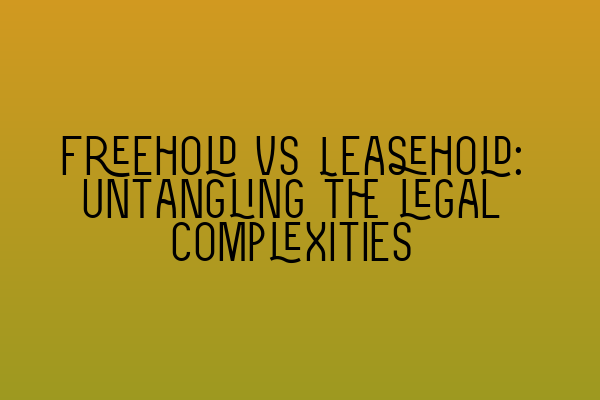Freehold vs Leasehold: Untangling the Legal Complexities
In the intricate world of property law, one of the fundamental distinctions that must be understood is the difference between freehold and leasehold ownership. These terms refer to the legal rights and responsibilities associated with owning or leasing a property. Whether you are a potential buyer, tenant, or even a legal professional, it is vital to comprehend the intricacies of freehold and leasehold, as they can have a significant impact on property ownership, rights, and obligations.
What is Freehold?
Freehold ownership represents the most complete form of property ownership. When you own a property freehold, it means that you own both the land and the building outright, with no time limit on your ownership. In essence, you possess absolute ownership, and it can be referred to as “ownership in perpetuity.”
As a freeholder, you have control over all aspects of the property and are responsible for its maintenance, repairs, and any associated costs. You also have the freedom to make alterations or extensions to the property, subject to any necessary planning permissions or building regulations.
Freehold ownership is highly desirable for many individuals, as it provides a sense of security and autonomy over the property. It allows you to have a long-term investment and pass the property to future generations.
What is Leasehold?
Leasehold ownership, on the other hand, is a more limited form of property ownership. With leasehold, you have the right to occupy and use the property for the duration of the lease, but you do not own the land outright. Instead, you own a leasehold interest, which is essentially a contractual right to use the property for a specified period, typically ranging from 99 years to 125 years.
When the lease expires, the ownership of the property reverts back to the freeholder. Therefore, leasehold ownership is temporary, and you are essentially a tenant of the freeholder. This means that you are subject to certain restrictions imposed by the freeholder, such as obtaining consent for alterations, paying ground rent, and service charges.
Leasehold properties are commonly found in apartment buildings, blocks of flats, and certain types of housing estates. In these cases, multiple leaseholders share common areas and amenities, with the freeholder responsible for maintaining and managing them.
Advantages and Disadvantages of Freehold and Leasehold
Understanding the advantages and disadvantages of freehold and leasehold ownership is essential when considering purchasing a property. Here are some key points to consider:
Advantages of Freehold:
- Complete ownership and control over the property
- No ground rent or service charges to pay
- Potential to increase property value through improvements
- Ability to pass on the property to future generations
Disadvantages of Freehold:
- Responsibility for maintenance and repairs falls solely on the freeholder
- Potential for disputes with neighbors regarding property boundaries
Advantages of Leasehold:
- Access to shared amenities and common areas
- Less financial responsibility for maintenance and repairs
- Opportunity to live in desirable locations that may be unaffordable for freehold properties
Disadvantages of Leasehold:
- Ongoing ground rent and service charges
- Restrictions on alterations and modifications
- Potential for disputes with the freeholder or other leaseholders
Legal Considerations for Freehold and Leasehold
When dealing with freehold or leasehold properties, there are several legal considerations to keep in mind:
- Conveyancing: The process of transferring ownership of a property involves legal documentation and checks. It is crucial to engage a solicitor experienced in property law to handle the conveyancing process.
- Lease Agreements: For leasehold properties, a lease agreement is essential. This agreement outlines the rights and responsibilities of both the leaseholder and the freeholder and should be carefully reviewed before signing.
- Collective Enfranchisement: Leaseholders may have the right to collectively purchase the freehold of their building through a process called collective enfranchisement. This can provide leaseholders with more control and financial benefits.
- Lease Extensions: Leaseholders also have the right to extend their lease once it reaches a certain point. It is essential to understand the process and implications of extending a lease.
- Leasehold Valuation Tribunal: In case of disputes between leaseholders and freeholders, the Leasehold Valuation Tribunal (LVT) can be approached for resolution.
Conclusion
Understanding the differences between freehold and leasehold ownership is vital when it comes to purchasing a property. Both types of ownership have their advantages and disadvantages, and it’s important to consider your personal circumstances and long-term goals before making a decision. If you require legal advice or assistance with freehold or leasehold matters, it is recommended to seek the services of a knowledgeable and experienced property solicitor to guide you through the process.
For more information about the SQE exams and preparation courses, you can check out the following related articles:
